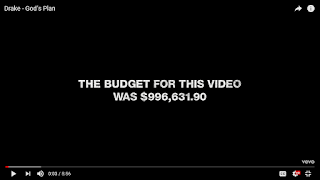Drake's God's Plan video
The use of text on screen being the opening shot attracts an audience filled with individuals who would be categorised as aspirers in Young and Rubicam's audience theory. Aspirers seek status in society and are likely to buy into brands that they feel will exaggerate their status and reputation. These people are extremely materialistic and will be attracted to the text on screen stating the budget for the music video. Ultimately, aspirers want to be celebrities with status and reputation and therefore will follow celebrities that are considered big and well known, like Drake. In the video, Drake gives out money to the public, to a specific group of people where it can be assumed that they're in need of help. By recording this and using the footage as a music video, aspirers may be encouraged to also help people who are struggling in hopes of being like Drake.
Also the music video makes people feel good about themselves as they're fans of someone who using their success to help others.
Following this, and at the end of the video, a mid shot is used to show a man who seemingly is rambling about looking good and presidents. The dialogue captivates audiences as he's seen as wacky and they are confused as to what he is doing and why the footage has been added into the video. However, the purpose could be to add context to the type of areas and people Drake is helping as it could be suggested the man has a mental health issue, something that is prevalent in struggling area. suggested mental health. Further more, mid shots are used to generally emphasis interaction between a group of people. However, the character isn't shown to have an audience inside the music video and therefore is can be adopted as the character talking directly to the audience. This use of direct address appeals to audiences as it makes the situation more personal to audience members.
The constant use of white surrounding Drake in the video, and just in the video in general connotes an almost godly vibe, which is furthered by the god connotations in the lyrics and the title 'God's Plan'. This perception of Drake painting himself as a worker of God may cause a conflict in some audiences, or it may engage a particular audience further; specifically those who are big fans of his. Some people may be discouraged by the idea of Drake connoting that he is somehow connected to God and is carrying out his plan, as they may think it as disrespectful to God and religion. Whereas this perception may inspire fans to further look up to him as a role model. This perception is furthered by the use of long shots of Drake, accompanied by low angles. The long shots stress the white environment, which together make Drake seem almost powerful. Low angles connote power and status, something someone would possess if they were connected to God. The use of white and light colours also attracts an audience as it connotes cleanliness, which is something people are attracted to as cleanliness relates to organisation and success- which everyone aspires for.
The way that the music video was shot and captured makes the final product seem film-like. By doing this, it makes the video more entertaining and therefore it is easier for people to escape in; something the uses and gratification model says is a reason why audiences consume media. The film-like video offers a deeper window into the lives of those people featured in the product, which is successfully recreated by the inclusion of the moving footage of people's responses to the help they've received- this allows for a more empathetic response from the audience.
People who decode the music video with the oppositional reading will disagree or have a problem with the acts shown on the mise-en-scene. These people may see Drake's acts as being selfish and for the sake of self-promotion will the motive being purely about making himself seem better so more people will listen to his music and buy into him as a brand. By capturing himself helping other people it could be seen as him exploiting those who need help as he is using them to make himself look good in his music video. This perception is reinforced by the shots of people becoming overwhelmed by the sheer presence of Drake. Audiences who decode the video in this away may argue that Drake could have just given the money to charity and not made a video at all. The negotiated reading will be a conflict between the preferred and oppositional readings. Audiences may be caught in the idea conflicting ideas that Drake giving the money away was a good way to promote helping others, but also the idea that by putting this in his music video he is calling attention to what he done, rather than the actual action.





Very good analysis of the music video it included your thoughts and media specific terminology it would be nice if you compared it to another big music video for example humble by kendrick lamar.
ReplyDelete